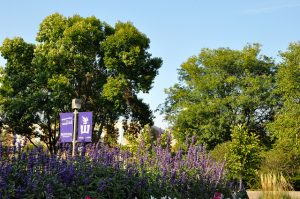
BARTHOLOME RONDET
Rebecca Mueller/Winonan
As the leaves begin to change, Winona State University’s campus arboretum continues to bloom.
Biology professor and land steward Bruno Borsari and the members of the Arboretum and Land Stewardship Committee have been working for the last 12 months on an application to designate Winona State as a Tree Campus USA.
Tree Campus USA is an Arbor Day Foundation program created to recognize colleges and universities that excel in managing the trees on campus and encouraging student and community involvement.
“We think this would further distinguish Winona State as a state university,” Reynolds said.
Upon becoming a Tree Campus USA, Winona State would join 192 other colleges and universities across America that also share this title. Six Minnesota technical colleges are considered Tree Campus USAs, but no Minnesota state universities have this distinction.
The campus arboretum on Main Campus features more than 100 kinds of trees, including more than 50 species native to Minnesota.
In order to become a Tree Campus USA, Winona State must meet five standards set by the Arbor Day Foundation, and the application must be approved by the Minnesota Department of Natural Resources.
In the first standard, the university must have a Campus Tree Advisory Committee. Borsari and professor emeritus Jim Reynolds are co-chairs of the All-University Arboretum and Land Stewardship Committee, a group of 16 faculty, staff and students.
The committee features three master gardeners, including Reynolds’ wife Nancy, who is a tree care advisor and first detector for emerald ash borer.
“The goal of the arboretum committee is to declare the campus and all allied properties as a landscape arboretum,” Reynolds said. He views the arboretum as a living laboratory for education, public enjoyment and scientific study.
In the second standard, the committee must establish and follow a Campus Tree Care Plan. This plan includes strategies for planting, maintaining and protecting the trees on campus.
To meet the third standard, Winona State must set aside funds for the campus tree program. These funds would include the cost of the trees, maintenance equipment and supplies, and staff and volunteer labor.
The fourth standard requires the university to hold an annual Arbor Day observance either on campus or in the community. Winona State celebrated its first annual Arbor Day event last year.
In the final standard, the university must provide opportunities for students to participate in a Service Learning Project, which is meant to build interest about trees through volunteer experience. Winona State already provides several opportunities for students to get involved, and Borsari said he hopes to offer even more.
“It is a very inclusive type of educational agenda,” Borsari said. He would like to provide opportunities for every major, be it the sciences or the liberal arts.
The newest feature of the arboretum is the prairie garden recently installed next to the Integrated Wellness Complex. The project was designed as part of former Winona State student Kaitlyn O’Connor’s capstone project.
The arboretum is currently centered on Main Campus, but it will eventually extend to include West Campus, East Lake Apartments and the Krueger Forest near Garvin Heights. There will also be a stronger focus on trees native to southeast Minnesota.
“No other institutions in the Minnesota State Colleges and University system have an arboretum,” Borsari said. The distinction of Tree Campus USA would further elevate Winona State’s unique status.
The arboretum has been building a stronger presence on Main Campus with the addition of small signs next to the trees. These signs feature both the trees’ common names and scientific names. The signs also feature a QR code that can be scanned to learn more information, including pictures and facts about the trees, along with suggested routes for self-guided tours.
Borsari and Reynolds will present a CLASP talk on Oct. 2 called “WSU Land Stewardship” to spread the word about the arboretum.
In addition, the Arboretum Committee is planning to hold an event to unveil the arboretum next spring. The event will either take place in conjunction with the Arbor Day event or as an entirely separate occasion.
Borsari expects to complete the application in 2014.
Contact Rebecca at [email protected]




























































